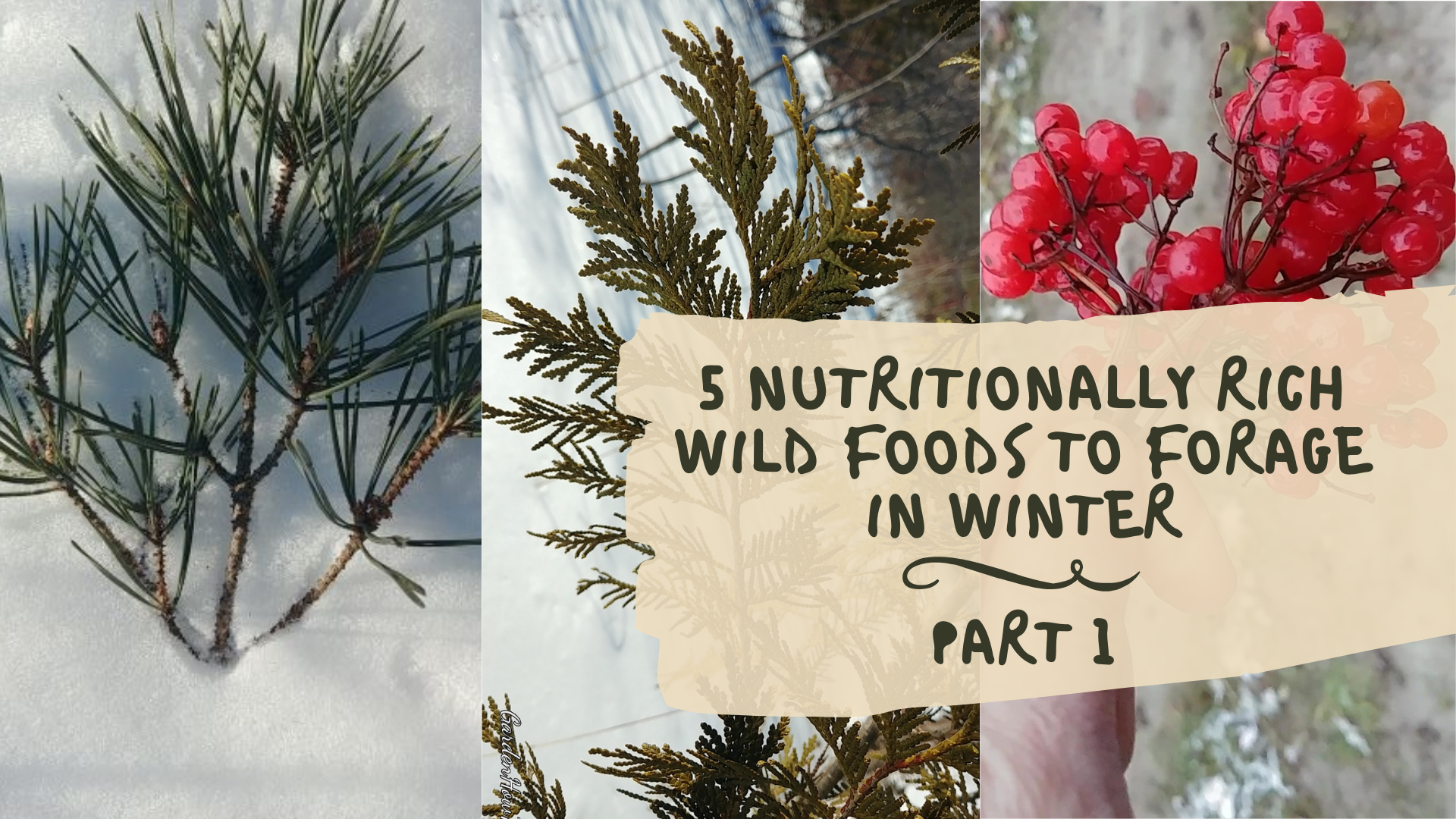When I explored the native wilderness as a child I was always curious to find wild edibles. The treasures of the wild attracted me because they are usually flavourful and smelled aromatic. The moistened by recent rainfall and hidden under leaves wood released a pleasant scent, or a bright berry that I could soak the juice from, or a piece of branch that I could chew to extract some unique and unrepeatable taste. The natural taste of the wild that could not be created in the processed food industry or derived from the fruits and vegetables. That magic of the scents and flavours stimulates my trips to the wilderness.
Now, while living here in Canada, I realize that store-bought food is plain and tasteless, and the only way to enjoy cooked meals is by adding herbs and spices. But unless you grow herbs and spices in your yard the ones you buy in the store are not as natural either. How about borrowing flavors from the wild and incorporating them into our cuisine?
In wintertime to maintain health and vitality, our bodies ask for nutrients and vitamins as never before. Look around in your local wilderness and you will notice that you live in an abundance of wild foods. Wild plants are immune to all possible harmful influences. When you pick wild plants and eat them you improve your own immunity. Additional medicinal benefits depend on what specific plant and what part of it you pick – a flower, a seed, a piece of bark, or a mushroom.
I invite you to watch the video below and dive with me into adventures with wild plants. Trying to make it simple, I focused only on five plants that you can easily find around where you live in wintertime and hope it will not take much of your effort to discover them. You will see me browsing through the bushes in climate zone 5b. The plants mentioned in the video spread out wider though, the only difference might be in finding the exact species of the plants in your area.
Nature is abundant any time of the year even in the coldest thyme of year. We can find beneficial edibles in the wilderness and enhance our food experience, improve our health and benefit our well-being. You might agree that in the winter it’s not as easy to find edibles. You might think they are covered by the snow or because there are no leaves on the trees there are no edibles but take a glance at the evergreens. They clean the air around us 12 months of the year and while other trees and bushes are in a dormant state the evergreens are wide awake, so let’s start by exploring the evergreens.
1. Pine Needles
I stop at this pine tree that has long and pretty needles which are a good source of Vitamin C. This particular tree is the White pine. You will be safe to forage needles from the following pines:
- White pine (considered to be the best tasting)
- Slippery Elm
- Black Birch
- Yellow Birch
- Red Spruce
- Black Spruce
- Balsam Fir
- Tamarack *
There are three exceptions of the pines where the needles are considered poisonous:
- Yew,
- Norfolk Island Pine (also known as Australian Pine)
- and Ponderosa Pine.
I like the White pine because it has long needles and they are not prickly. They’re very soft, so it’s quite easy to work with them. I typically take only needles but you can take them with the tips too. I mean you can pick up the tiny branches with the leaves on them too. In order to extract a sensible pine essence, you have to collect a good bunch of leaves.
When I started to cut them they released their refined smell of the pine and by chewing them you can taste a very slight acidity of Vitamin C. Yes, you can chew raw needles and swallow the Vitamin C from them without any processing.
They taste delicious to me.
So how can you use pine needles in your cuisine?
You can simply brew pine needles tea.
You can advance to cooking the pine cough syrup to clean your respiratory tract.
You can infuse the needles in the apple cider vinegar or make the drinkable vinegar step-by-step:
- grinding the pines,
- infusing them in the apple cider vinegar,
- straining them
- and then drinking that vinegar infused with the pine essence.
You can also roast fish with pine needles inside (trout or salmon, any good-sized fish if you unleash your imagination) or marinate the trout with the pine needles so that your trout inhales the pine flavor before you smoke it. **
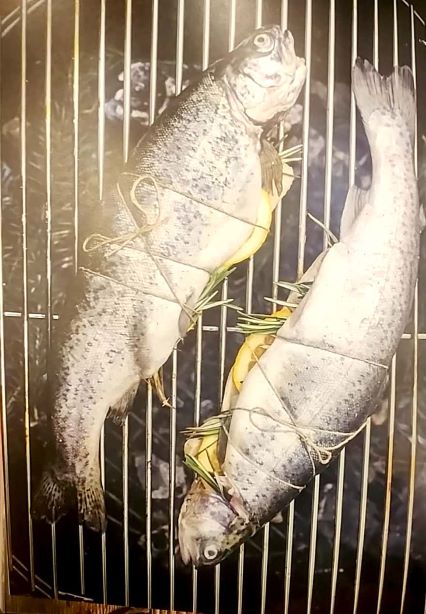
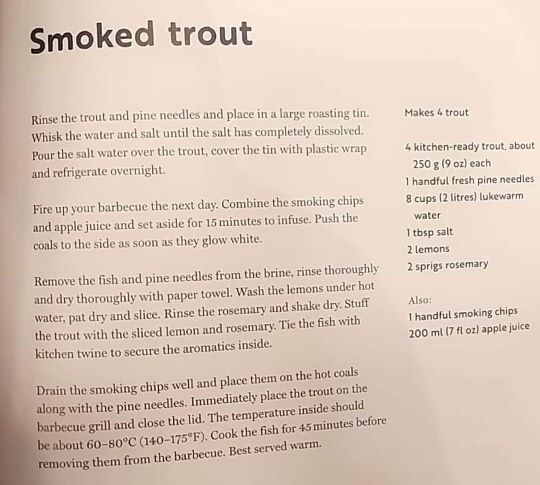
Or you can go further to dry the needles, make a powder from them and sprinkle that powder into your morning smoothie, cereal or ice cream.
And if you’d like to preserve not only your physical but also mental health get yourself immersed in the following scented bath (don’t ask me why it’s men-only though 😉) ***:

2. Cedar Leaves
This is the white cedar with these beautiful leaves which are sacred in native cultures. As soon as you grab the leaves, rub them together they smell amazing. Don’t you want this smell to purify the air in your bedroom, or in a bathroom, or in the kitchen, especially during the wintertime?
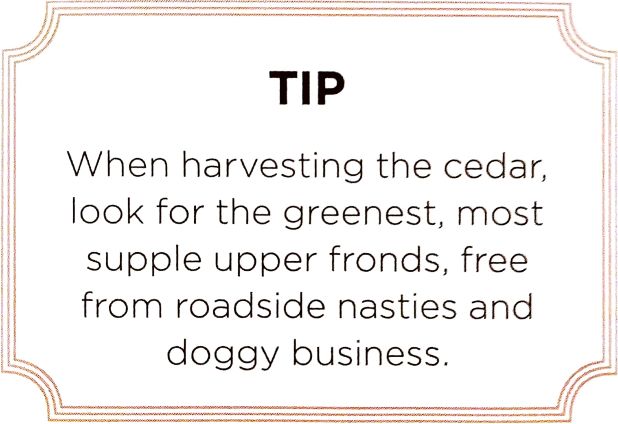
Here is how you can enjoy cedar leaves in food:
Same as with the pine needles you can pick up the cedar fronds and brew the cedar tea. Infuse cedar fronds in hot water, it doesn’t have to be boiling water. This tea is excellent for treating muscular aches and pains, chronic coughs, fevers, and gout.
When you mix cedar leaves in tea with sage you make a beneficial elixir that cleanses your body from all of the winter infections.
Also same as for the pine needles, here is a quick fish roasting recipe you can play with cedar leaves:
Lay fish, skin side down, on top of potatoes and beets, lay washed cedar fronds over fish to cover, then pour stock over cedar and trout. Cover with lid or foil; bake until a paring knife can easily be inserted into a potato or beet and the fish flakes with a light tug, about 30 minutes.
You can marinate your steak on the bed of the cedar fronds so that the steak will extract medicinal properties and delicious flavor. When we eat steak we don’t necessarily think about medicines, right? ☺
But first of all, we have to extract the nice flavor to enjoy the steak. I’m not a steak eater anymore but you can still enjoy eating good meat, I mean grass-fed meat and use the cedar leaves to enhance the flavor of your meat, why not?
As a bonus, check these amazing cedar recipes:
- Cedar leaves and berries infused in sunflower oil
- Cedar infused water
- Cedar hot drink
- Cedar salt/scrub
I thank this cedar tree for giving me the chance to pick some of its leaves.
Being very thankful to Mother Nature I’ll go ahead to find winter berries. Yes, even in this cold season you can still find berries on the bushes so stay tuned and help me warm my fingers from the cold. The air is very humid plus cold rain that is converted to snow while I’m chewing the needles 😋, that’s why my fingers are getting frozen and that’s why I was wearing the gloves when I was showing you the pine needles too so please bear with me.
3. Highbush Cranberry
I’m back with you at this Highbush Cranberry or otherwise called Guelder Rose (or one type of Viburnum) bush. There are several varieties of Viburnum and not all of them are good for picking.
You might have seen very beautiful bushes of Viburnum, sometimes planted for decorative purposes or as hedges. They produce berries that look exactly the same but I wouldn’t suggest using those because you don’t collect them for the display, but for eating and using them as a home remedy.

So to simplify the search make sure to pick berries from the native viburnum that grows wild. As per eattheweeds.com:
Among the consumed Viburnums are:
Viburnum alnifolium,
Viburnum cassinoides,
Viburnum edule,
Viburnum lantana,
Viburnum lentago,
Viburnum nudum,
Viburnum opulus,
Viburnum prunifolium,
Viburnum rufidulum,
Viburnum setigerum,
and Viburnum trilobum.
You can chew the berries right away from the bush. Their flavor is kind of sweet with a slight bitterness, though this flavor is not for everybody’s taste. Each berry has a flat seed inside. You can spit out the seed or you can swallow the seed. There is nothing wrong with eating the seed. What is truly beneficial in these berries is the juice. Almost all nations have favorite plants-symbols. Canadians have maple, and we Ukrainians have willow and viburnum. My grandma always kept these berries in the house as a home remedy.
Here is what a Ukrainian folk legend says about viburnum (Kalyna in Ukrainian):
Once in our long history, so many attacks happened on our land. And then the Turks came. And this was in the days of Kievan Rus. There were rumors then that the main Turkish voivode was wounded by a poisoned arrow, and the poison was deadly. And those who save the voivode were promised a reward. Many doctors and healers came from all over, but no one could help. Then a girl came to the camp. Although in poor clothes, she was so beautiful that it was impossible to take his eyes off her. The voivode ordered her to enter.
The girl walked into his tent and did not bow, but stood with her head proudly raised. Servants rushed to her and brought a sword over her head, but the governor stopped them.
“Tell me, why didn’t you bow to me?” “I have conquered the hemisphere, kings worship me,” said the voivode.
And the girl answered:
– You must bow to me, because you came to my house, to my land. I’m not afraid of you. You will die in two days, and there is nothing more precious than life in this world.
The voivode turned pale.
“If you don’t help me with your prophecy, I’ll have your head cut off.”
The girl said:
– I had a dream. In a dream I saw an eagle. He looks like you with his nose. He burned cities and villages, and drove people into slavery in his country. So he was lucky for 307 days. At 309 he died of a poisoned arrow. Here, voivode, count all the days of your glory.
When his servants were expelled, everything came together.
“What do you want from me?” He asked.
– First of all, bow to the very holy land, and let your servants bow down.
The voivode and all the servants fell to the ground.
“Now listen,” she said. – I’ll give you back my life. Release all prisoners to their homes. They need to sow, plow, and raise children. Leave my land, write with your blood that you will never come to plunder my people.
– I’ll do as you say. Just promise to come with me.
“I will do my best for my people, conqueror,” replied the girl.
She cured the voivode and went with him, and while leaving, she said goodbye to sister Kalyna: “In your name, sister, I will call this plant, which I love the most, because it grows in the best corners of our precious land, admires people with its beauty and restores their health.”
Since then, the name Kalyna was applied to this precious plant.
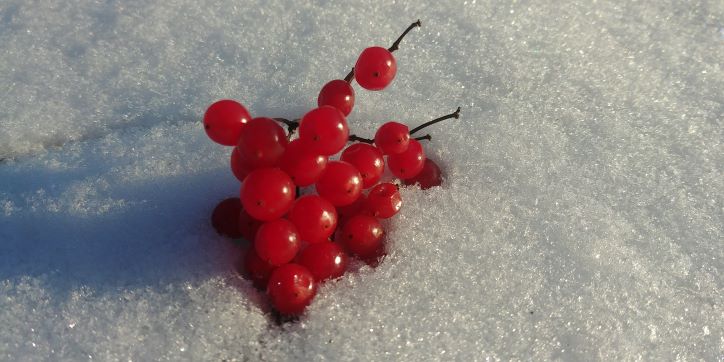
Here is how you can enliven your daily cuisine with highbush cranberries:
- Collect and clean them from all of the woody sticks, fill a jar and cover with sugar. Then put that jar in the fridge to let the sugar release the juice. What you will be doing is pretty much fermenting the berries in sugar.
That’s how easy it is to preserve them and then… whenever thyme comes… when you feel cold or flu symptoms… you just take a tablespoon…, actually… one tablespoon is not enough. Take three or five tablespoons and enjoy the juice from them.
- Of course you can apply these berries to any jam.
- Oven-baked viburnum porridge or berries baked in the dough are known as a rural delicacy.
Berries are rich in sugars and pectins. They were used to make wonderful marmalade and jelly, they are a good seasoning for meat dishes and a good filling for pies. From viburnum berries you can get food coloring, and from the bark – a dye that turns the wool dark green.
From long ago viburnum has been given an important place in medicine. Until now perhaps the best known remedy for coughs, colds, fever is viburnum tea with honey. Viburnum berries increase heart rate, have a good effect on the kidneys, and are useful in multiple sclerosis and hypertension. Scientific medicine uses viburnum bark. It has a large set of complex organic substances which are able to narrow blood vessels. Therefore, extract from highbush cranberries is known as an effective hemostatic agent.
Next time when you’re going to make your sauerkraut, add Viburnum berries as I’ve done before. You can add them to any fermenting vegetables when you play with fermentation.
Feel free to write a comment below if you’re interested in learning more about fermentation or send an email to ga*********@gm***.com and I will make videos on that topic.
I’m really curious what you think about what I’m creating on this website so don’t hesitate to give me your feedback because I create content for you guys and I’m interested to know what you would like to learn.
So I’m very much looking forward to hearing from you.
You can collect highbush cranberries beginning from the fall as soon as the leaves start to drop from the bushes. They become sweeter when they are hit by the frost, so in the winter they are more flavorful than in a fall.
The coldness of the frost enhances the flavor of the wild foods in many cases and highbush cranberries are the best example to experience this difference in the flavor.
In fact, I write to you, and I really want you to feel “at home” on this website and want to come here again. That is why I am interested in knowing your opinion on what else you are curious about in the world of wild, nutritious food. Feel free to comment below.
P.S. I’d love to invite you to join my online community if you feel inclined.
P.P.S. Part 2 continued, click here 😉

